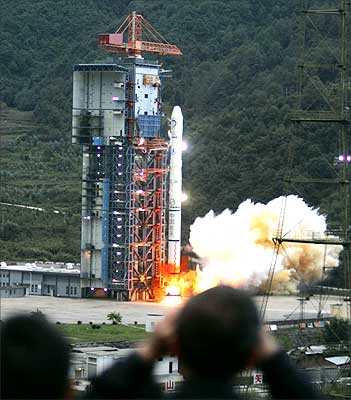|
|
| Help | |
| You are here: Rediff Home » India » News » First Look |
|
 China on Wednesday successfully launched its first lunar probe, marking the start of its long-term odyssey to put its man on the moon by 2020.
China on Wednesday successfully launched its first lunar probe, marking the start of its long-term odyssey to put its man on the moon by 2020.
Carrying lunar orbiter Chang'e 1, China's workhorse rocket, Long March 3A, blasted off at 6.05 pm local time, leaving a trail of smoke and orange flame in a textbook launch from Xichang Satellite Launch Centre of southwestern Sichuan province.
"The launch was very successful, and everything is proceeding just as planned," said Wu Ji, director of the Space Science and Applied Research Center under the Chinese Academy of Sciences.
The 2,300 kg satellite, by far the most sophisticated one built by China, will beam the first picture of the moon in late November and continue its lunar exploration for a year, the official Xinhua news agency said.
Chang'e 1, named after a legendary Chinese goddess who flew to the moon, is expected to enter earth-moon transfer orbit on October 31 and move to the moon's orbit on November five.
The launch of the orbiter marks the first step in the three-stage moon mission. The second phase is a moon landing and launch of a moon rover around 2012 and in the third, another rover will land on the moon and return to earth with lunar soil and stone samples around 2017.
The satellite, that cost 1 to 1.4 billion Yuans, will also carry out a series of projects, including acquiring 3D images and analysing the distribution of elements on the moon's surface, it said.
Chang'e 1 began using solar energy for power supply as its solar panel was unfolded about an hour after the launch, the official media reported.
TV pictures, beamed live to millions of domestic audience, showed the rocket soar majestically into space in clear weather after unexpected torrential rainfall in the early hours caused anxiety to space scientists.
Villagers living within a 2.5 km radius of the launch site were asked to shift to safer places two hours before the launch, while thousands of tourists and onlookers watched the lift-off.
Chang'e has been worshipped as the 'moon lady' for thousands of years in China, which became the third nation after the US and Russia [Images] to send a man into space aboard its own flight in 2003 and carried out manned space flight with two astronauts into orbit in 2005.
Fuelling global concerns about space arms race, China had destroyed one of its satellites with a ground-based missile in January.
The launch of Chang'e by China comes within weeks after Japan [Images] put its satellite in high orbit over the moon in an undeclared space race in Asia, with India also working on its lunar mission.
However, dismissing the talk about space race, Luan Enjie, Chief Commander of the Orbiter project, told Xinhua, 'China will not be involved in lunar probe competition in any form with any country.'
China, he said, would 'share the results of its moon exploration with the whole world' in its pursuit of a policy of peaceful use of airspace.
As the state-run Chinese TV played patriotic songs to hail the milestone, Chinese President Hu Jintao congratulated the scientists on the successful launch.
Image: The Long March 3A rocket carrying China's first lunar probe Chang'e I blasts off from the Xichang Satellite Launch Center.
Photograph: Getty Images
|
|
| © 2007 Rediff.com India Limited. All Rights Reserved. Disclaimer | Feedback |